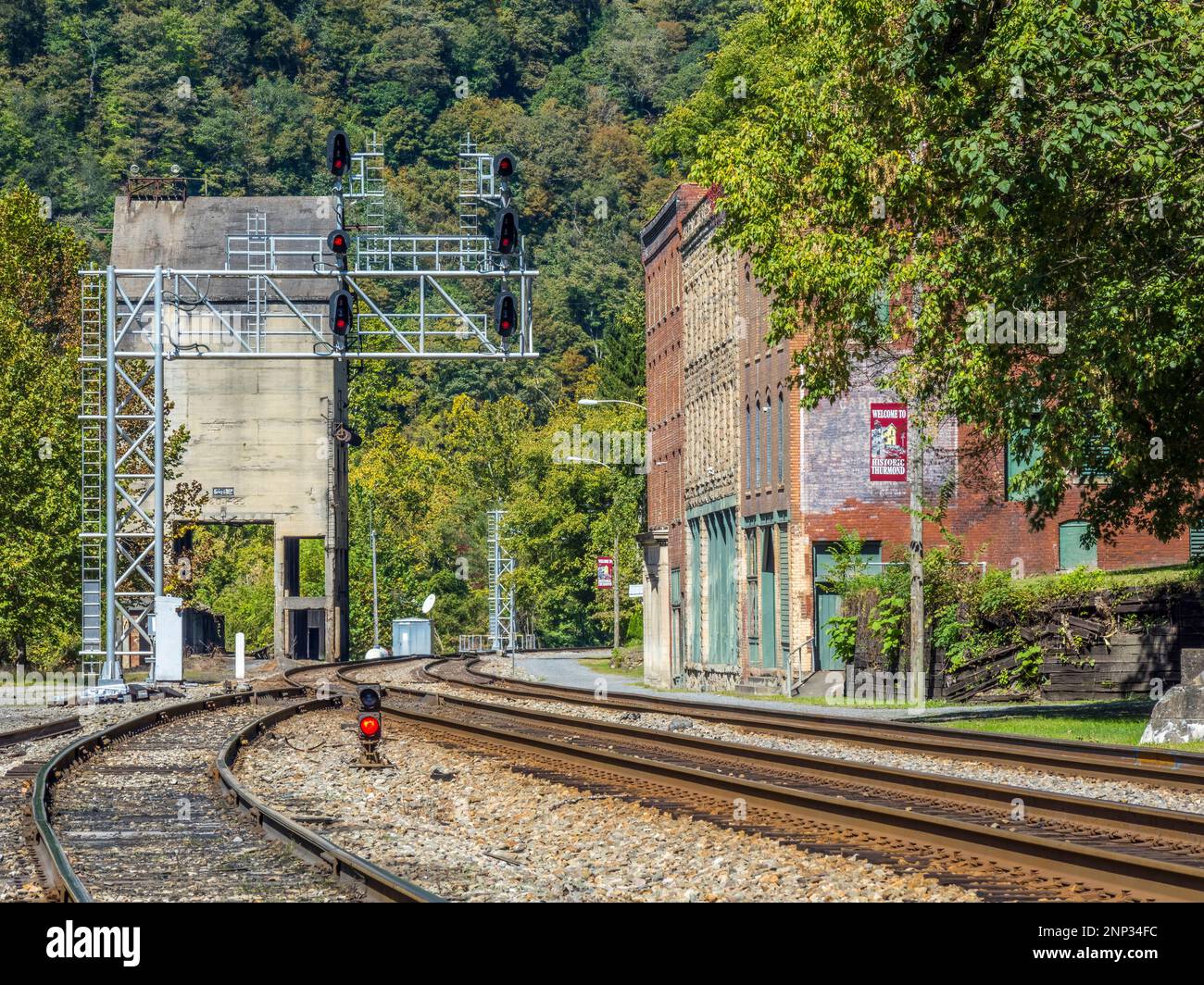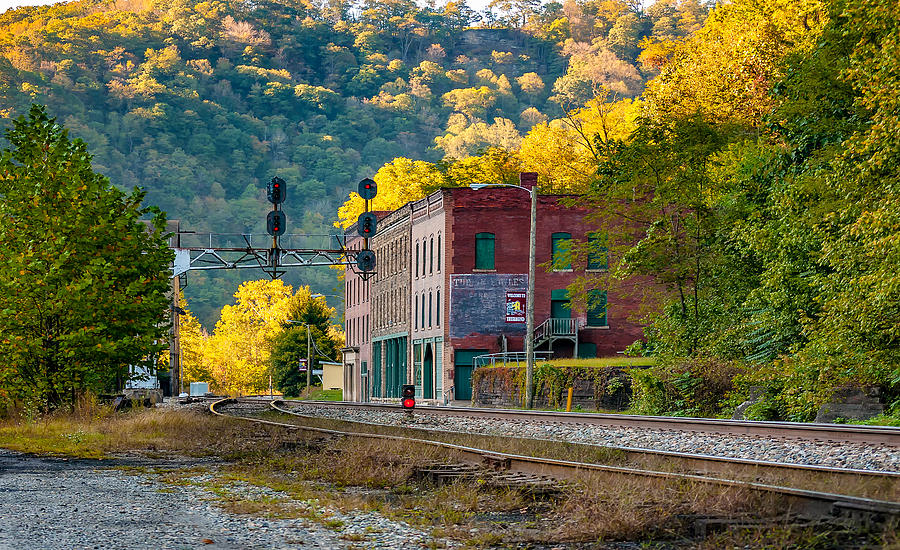
Echoes in the Gorge: Unearthing the Ghosts of Thurmond, West Virginia
The silence of Thurmond, West Virginia, is not an empty void, but a profound canvas upon which the echoes of a roaring past are painted. Tucked deep within the dramatic embrace of the New River Gorge, this once-bustling coal and railroad town now stands as a testament to the fleeting nature of prosperity, a living museum of boom and bust, whispered legends, and the enduring power of nature to reclaim its own. To visit Thurmond today is to step into a time capsule, a place where the ghosts of a thousand train whistles and a million dollars in coal revenue still seem to hang in the crisp mountain air.
Just a handful of souls call Thurmond home now, a stark contrast to the hundreds, even thousands, who thronged its wooden boardwalks and packed its saloons at the turn of the 20th century. The grand Chesapeake & Ohio (C&O) Railway depot, meticulously restored by the National Park Service (NPS), serves as the primary outpost for visitors, its Victorian elegance a poignant reminder of the town’s former glory. From its platforms, one can still hear the rumble of freight trains – long, modern giants of steel – as they thunder along the very tracks that once carried the lifeblood of America’s industrial revolution. But unlike the continuous procession of coal cars and passenger coaches that defined its heyday, these trains are now fleeting apparitions, their passing only emphasizing the quiet that descends once they vanish around the bend.
Thurmond’s story is inextricably linked to two powerful forces: coal and the railroad. In the late 19th century, as America’s industries clamored for fuel, the New River Gorge revealed its black gold. But getting that coal to market was the challenge, and the C&O Railway was the answer. Thurmond, established in 1891 and named after Captain W.D. Thurmond, who owned the land, was strategically positioned at a critical junction. It became not just a stop, but a major switching yard and coaling station, handling an astonishing volume of freight.

"Thurmond was once one of the busiest rail hubs on the entire C&O line," explains a park ranger, leaning against the polished wood of the depot’s ticket counter, his voice resonating slightly in the high-ceilinged room. "It wasn’t just coal; it was the gateway for everything coming out of the gorge – timber, passengers, mail. For a time, it generated more revenue for the C&O than Cincinnati, Ohio, which was a huge city." This single fact encapsulates the almost unbelievable scale of Thurmond’s economic power.
The town exploded. By 1910, Thurmond boasted two banks (the National Bank of Thurmond and the New River Banking and Trust Company), two hotels (the Thurmond Hotel and the Lafayette Hotel), dozens of stores, restaurants, a movie theater, and more saloons than one could count. It was a place where fortunes were made and lost, often in the same night. The constant flow of coal miners, railroad workers, timbermen, and entrepreneurs created a vibrant, often lawless, atmosphere. This wasn’t the genteel South; this was the "Wild West of the East."
Gambling was rampant, and legend has it that one poker game at the Thurmond Hotel ran continuously for 14 years. Shootouts were not uncommon, and the town’s isolated location meant that law enforcement was often a distant, ineffective presence. "Imagine the scene," the ranger continues, gesturing towards the empty tracks outside. "Steam engines belching smoke and cinders, the clang of coupling cars, the shouts of men, the clinking of glasses from the saloons, the smell of coal smoke and whiskey. It was a 24/7 operation, a cacophony of industry and human endeavor."
Wealth accumulated rapidly for some. Coal barons and railroad executives built impressive homes on the hillsides overlooking the bustling tracks. The banks in Thurmond were formidable institutions, handling immense sums of money from coal leases, payrolls, and the constant transactions of a thriving economy. At its peak, the population of Thurmond itself may have only been a few hundred, but thousands passed through daily, and the surrounding hollows and coal camps relied entirely on Thurmond as their commercial and social center. It was the nerve center of the New River Gorge.
But just as quickly as it rose, Thurmond began its slow, inevitable decline. The very forces that built it ultimately led to its undoing. The first blow came with the advent of diesel locomotives in the mid-20th century. Diesel engines didn’t need to stop for water and coal as frequently as steam engines, reducing the necessity of Thurmond as a major service hub. Improved roads and the rise of trucking also meant that coal and goods could bypass the railroad, further diminishing Thurmond’s strategic importance.
Then came the decline of the coal industry itself. As accessible seams were depleted and the demand for coal shifted, many mines in the gorge closed. The Great Depression delivered another crushing blow, crippling the economy and forcing many to leave in search of work elsewhere. Businesses closed, one by one. The grand hotels became silent, their windows staring blankly at the diminishing activity. The banks, once symbols of immense wealth, eventually consolidated or shut down. By the 1950s, Thurmond was a shadow of its former self.
By the 1980s, Thurmond was essentially a ghost town, its population dwindling to a mere handful. The once-grand structures slowly succumbed to the elements, their wooden frames rotting, their windows shattered. Nature, ever persistent, began to reclaim the land. Vines crept up brick walls, trees sprouted from forgotten foundations, and the sounds of the forest replaced the industrial din.
Yet, Thurmond refused to completely fade away. In 1995, the New River Gorge National River was established (later elevated to National Park and Preserve status in 2020), and the NPS recognized the immense historical value of Thurmond. The C&O Depot, the last remaining significant commercial building, was acquired and meticulously restored, opening as a visitor center. This intervention breathed new life, or at least a new purpose, into the dying town.

Today, Thurmond attracts a different kind of visitor. History buffs come to walk the quiet streets, imagining the past. Photographers capture the melancholic beauty of decaying structures against the lush backdrop of the gorge. Outdoor enthusiasts use it as a launching point for whitewater rafting trips on the New River, hiking, and exploring the surrounding wilderness. The river, which once carried logs and coal barges, now carries rafts full of excited adventurers, a new form of commerce for the region.
The irony is not lost on those who experience Thurmond. A place built on extraction and relentless industry now finds its value in preservation and recreation. The roaring river, once harnessed for power, is now appreciated for its untamed beauty. The isolation that contributed to its decline now enhances its appeal as a tranquil escape.
Among the few remaining residents is a deep-seated connection to the town’s past. One might occasionally encounter a local tending to their property, perhaps a descendant of those who witnessed Thurmond’s glory. Their presence is a quiet defiance against complete abandonment, a living thread connecting the present to the past. They are the keepers of the flame, the living memory in a town defined by its history.
Walking the deserted streets of Thurmond, one cannot help but feel a profound sense of melancholy, mixed with awe. The skeletal remains of former buildings, marked with interpretive signs, tell tales of forgotten lives and ambitions. The Thurmond Bridge, a steel behemoth spanning the New River, offers breathtaking views and a perspective on the sheer engineering prowess required to conquer this rugged terrain. Below, the river flows relentlessly, a constant in a world of change, carrying the waters of the Appalachians towards the Atlantic, just as it has for millennia.
Thurmond, West Virginia, is more than just a ghost town; it’s a powerful narrative about the American experience. It speaks to the relentless drive of human enterprise, the boom-and-bust cycles that have shaped the nation, and the ultimate humility of human endeavors in the face of time and nature. It reminds us that even in the quietest corners, history pulses vibrantly, waiting to be discovered by those willing to listen to the echoes in the gorge. As the sun dips below the rugged ridges, casting long shadows across the tracks, one can almost hear the faint, ghostly whistle of a steam engine, calling out across the silent, storied landscape of Thurmond.


